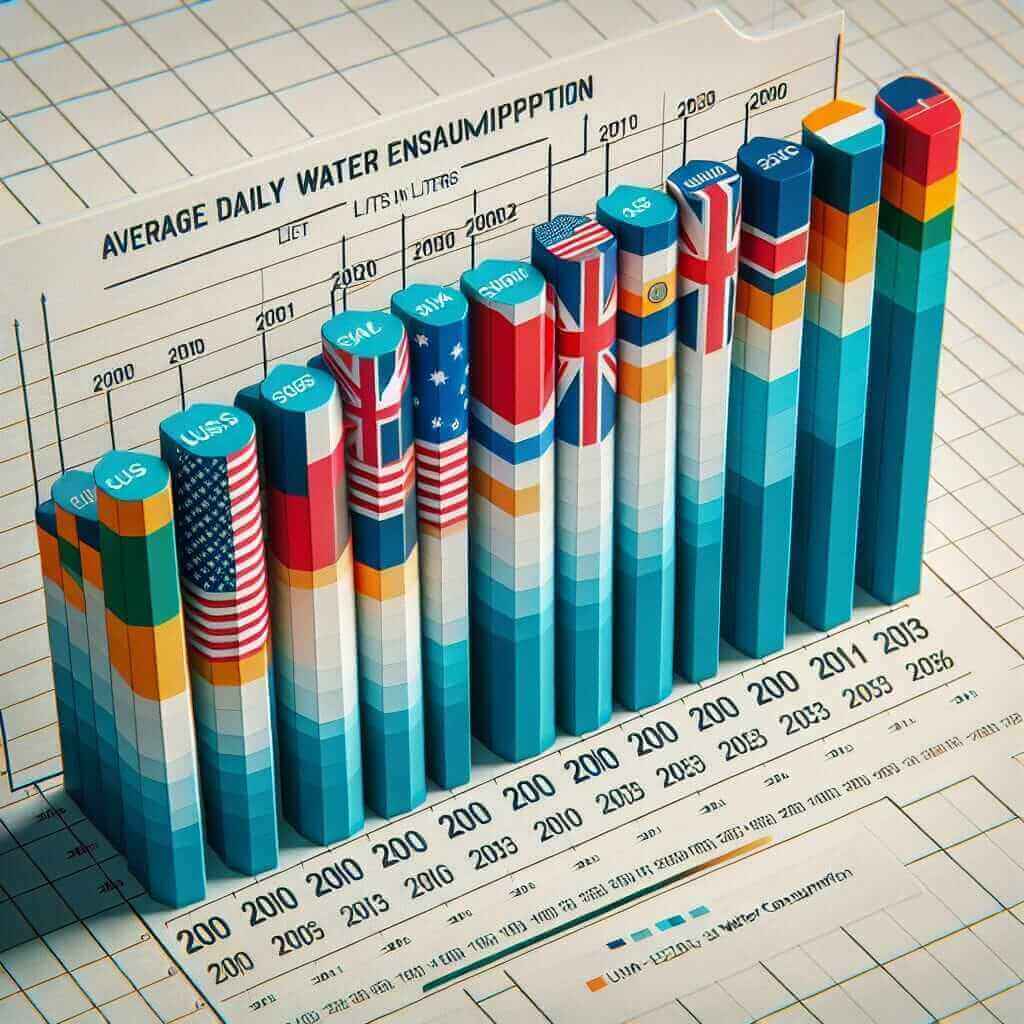The topic of “Average Daily Water Consumption in Various Countries (2000-2023)” presents an intriguing foundation for writing task 1 in the IELTS exam. This type of data is not only relevant in today’s world but also provides a rich source of analytical writing practice. Let’s break down the task and explore how to tackle it effectively for a high band score.
Common IELTS Task 1: Analyzing Graphs and Tables on Water Consumption
Graphs and tables depicting various statistics, such as water consumption, are frequent in IELTS Writing Task 1. They require candidates to summarize and compare data accurately.
Sample Task
You should spend about 20 minutes on this task.
The table below shows the average daily water consumption in various countries from 2000 to 2023.
Summarize the information by selecting and reporting the main features, and make comparisons where relevant.
Write at least 150 words.
| Country | 2000 | 2010 | 2023 |
|---|---|---|---|
| USA | 300L | 285L | 250L |
| Canada | 400L | 375L | 360L |
| UK | 150L | 160L | 140L |
| Australia | 220L | 210L | 190L |
| India | 110L | 130L | 135L |

Analyzing the Sample Task
Before writing, we must first analyze the table:
- Identify Trends: Look for upward or downward trends.
- Compare Data Points: Compare the water consumption figures across different countries and years.
- Highlight Key Features: Note significant changes or surprising data.
Sample Writing Task 1 Response
Introduction
The table provides data on the average daily water consumption measured in liters in five different countries – the USA, Canada, the UK, Australia, and India – over the period from 2000 to 2023.
Overview
Overall, it is clear that while the USA, Canada, and Australia have shown a consistent decrease in daily water usage, India has experienced an increase. The UK, however, has seen fluctuations within this period.
Body Paragraph 1
In the year 2000, Canada had the highest average daily water consumption at 400 liters, followed by the USA with 300 liters, and Australia with 220 liters. The UK and India consumed significantly less water, registering figures of 150 and 110 liters respectively.
By 2010, water consumption in the USA and Australia slightly decreased to 285 liters and 210 liters respectively, whereas Canada also showed a reduction to 375 liters. Meanwhile, the UK experienced a slight increase to 160 liters, and India’s consumption had risen to 130 liters.
Body Paragraph 2
By 2023, a drastic reduction in water consumption can be observed in the USA, which fell to 250 liters, as well as in Canada and Australia, where figures had dropped to 360 and 190 liters respectively. Contrarily, India’s average daily consumption rose slightly to 135 liters. The UK’s consumption dropped again to 140 liters in 2023, indicating more variability compared to the other countries.
Word Count: 203
Key Takeaways for Writing
Vocabulary & Grammar Tips
- Use comparative structures: “higher than,” “lower than,” “more significant decrease.”
- Use past and present perfect tenses appropriately: “has decreased,” “fell to.”
- Linking phrases are crucial for coherence: “Furthermore,” “Conversely,” “In contrast.”
Important Vocabulary
- Fluctuate (v) [ˈflʌktʃueɪt] – to change often.
- Consumption (n) [kənˈsʌmpʃn] – the act of using up something.
- Remarkable (adj) [rɪˈmɑːrkəbl] – worthy of attention; striking.
- Decrease (v) [dɪˈkriːs] – to become smaller or less.
- Trend (n) [trɛnd] – a general direction in which something is developing.
Conclusion
When tackling an IELTS Writing Task 1, it is essential to:
- Clearly summarize the main trends and key features.
- Use a variety of grammatical structures and sophisticated vocabulary.
- Ensure coherence and cohesion by using appropriate linkers and connectors.
Following this structured approach will help you achieve a high band score in your IELTS Writing Task 1. Remember to practice with datasets and tables similar to the one discussed for consistent improvement.